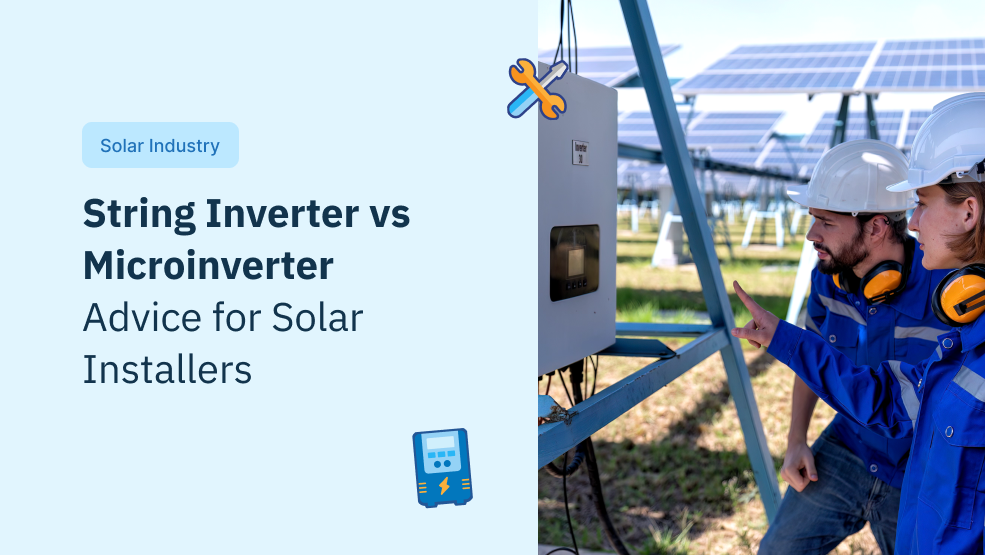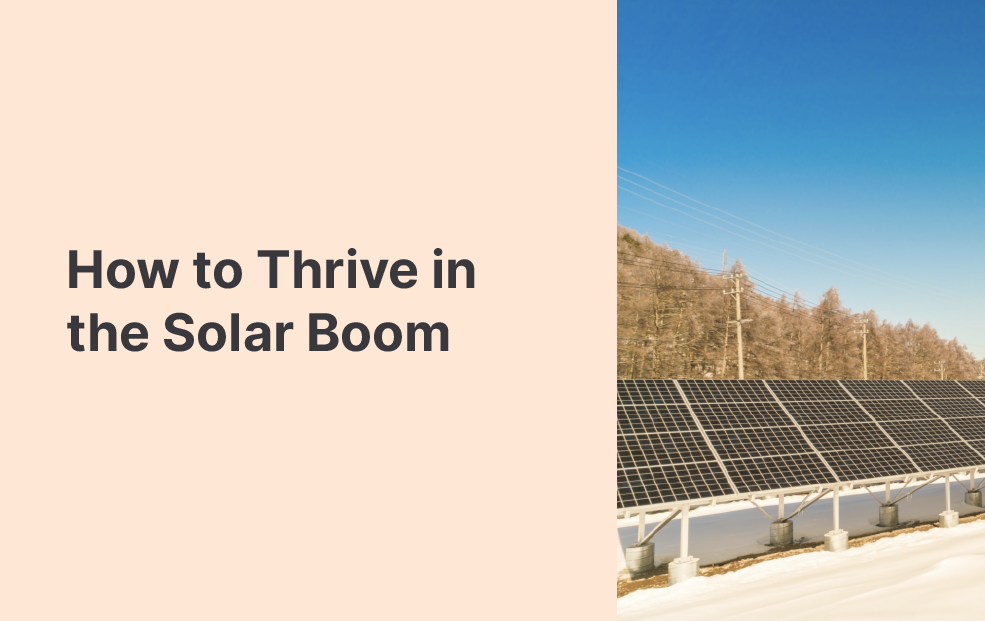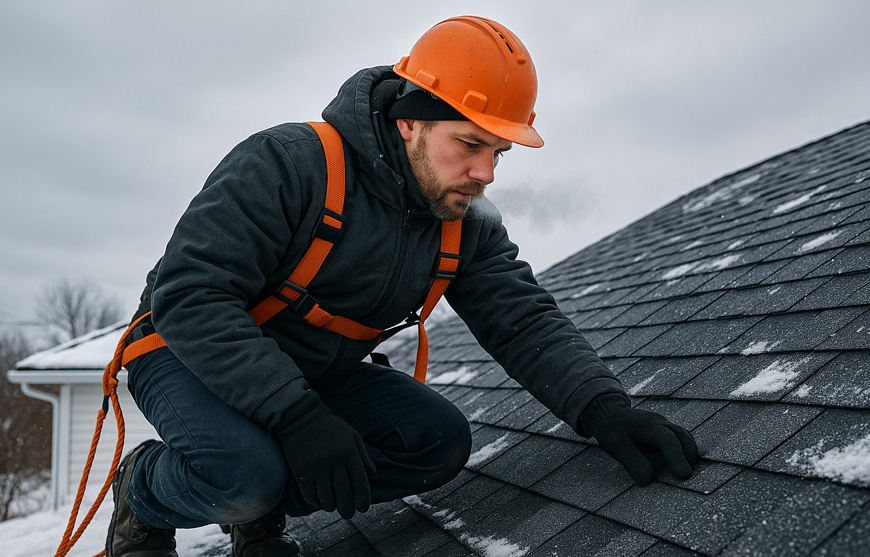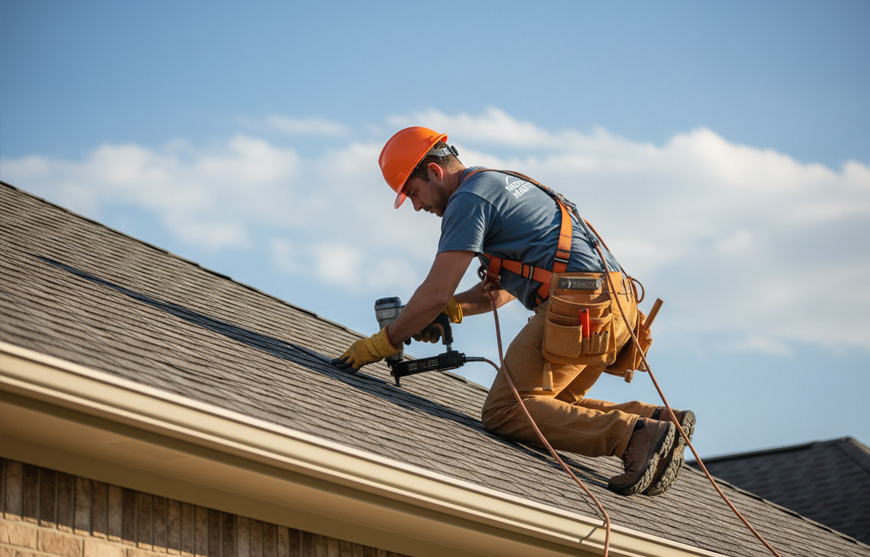The solar energy industry is experiencing unprecedented growth, driven by increasing awareness of environmental sustainability and the need for clean, renewable energy sources. According to the (SEIA) 2023 Solar Market Insight Report, the United States, in 2022, witnessed a remarkable surge in solar adoption across residential and commercial sectors by an astounding 51% increase. This booming industry has opened up vast opportunities for solar installers and highlighted the critical role of inverter technologies in enabling efficient and reliable solar power systems.
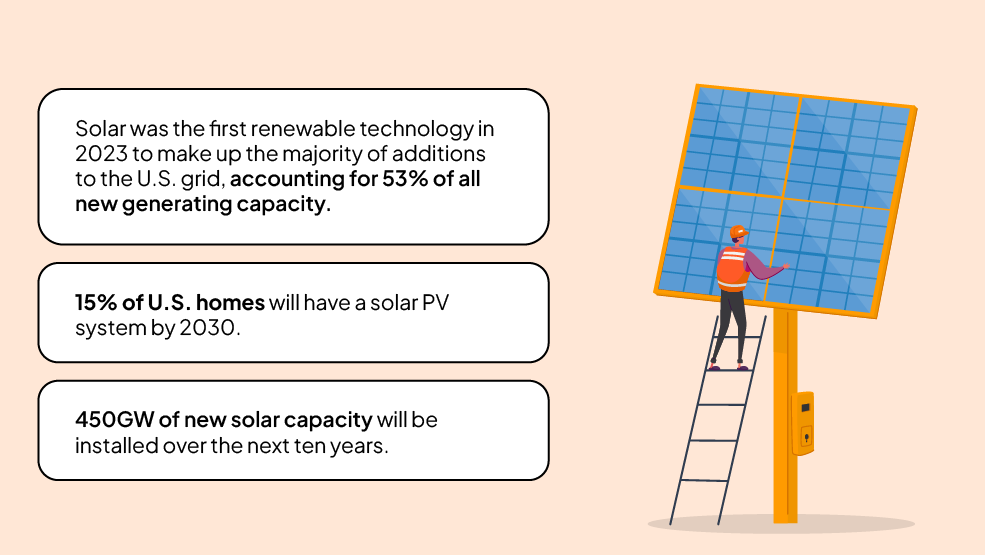
It is becoming evident that solar photovoltaics (PV) is rapidly becoming a dominant force in electricity generation. Driven by its cost-effectiveness, solar PV capacity has skyrocketed globally. From a mere 5 gigawatts in 2005, the capacity reached a staggering 1.18 terawatts by 2022. This immense growth highlights the increasing appeal of solar PV as a clean and sustainable energy source. North America has experienced exponential growth, surpassing 90 gigawatts as of 2021—this is enough to power the equivalent of 18 million average homes in the country. Though not the majority yet, solar contributes roughly 2.8% of the electricity generated in the United States. This increase in demand for solar energy has also created several opportunities in the solar industry. The US solar workforce continued to expand in 2022, reaching an estimated 263,882 jobs, with installation and project development remaining the top employment sectors.

Microinverter vs. string inverter, a battle of efficiency
The solar energy industry is experiencing a meteoric rise, with residential and commercial sectors increasingly embracing clean, sustainable power generation. According to the Solar Energy Industries Association’s (SEIA) 2023 Solar Market Insight Report, solar installations are breaking records, demonstrating a clear shift towards renewable energy solutions. But between the sun and our homes and businesses lies a crucial piece of technology, the solar inverter.

With individual panel optimization, microinverters minimize the effects of partial shading and panel-level variations, resulting in higher energy yields. Additionally, microinverters simplify monitoring and maintenance by providing granular-level insights into each panel’s performance. Their modular nature also allows for easier system expansion and reconfiguration, offering flexibility unmatched by centralized string inverters.
Key differentiators between microinverters and string inverters
One of the key differentiators between microinverters and string inverters lies in their ability to mitigate the effects of shading, panel mismatch, and temperature variations – factors that can significantly impact overall system performance. According to the National Renewable Energy Laboratory’s (NREL) report on Inverter Technologies for Solar Applications in the United States, microinverters offer distinct advantages in these areas. Shading, whether from nearby buildings, trees, or even dirt accumulation, can severely reduce the output of an entire string of panels when using a centralized string inverter. However, with microinverters, each panel operates independently, minimizing the impact of shading on the overall system. This results in higher energy yields and improved performance, even in less-than-ideal conditions.
Panel mismatches, which can arise from manufacturing variations or degradation over time, can also adversely affect string inverter systems. When panels in a string have differing characteristics, the entire string’s performance is limited by the weakest panel. Microinverters, on the other hand, optimize each panel individually, ensuring that underperforming panels do not drag down the rest of the system. Temperature variations can also impact inverter performance, with high temperatures generally leading to reduced efficiency. Microinverters are better equipped to handle these fluctuations. Each panel’s inverter can adjust accordingly rather than rely on a single, centralized inverter to manage the different panel conditions. Beyond performance advantages, microinverters offer ease of monitoring and maintenance. Microinverters simplify troubleshooting and maintenance tasks by providing granular data on individual panel performance, ensuring optimal system operation over time. Additionally, their modular nature allows for straightforward system expansion and reconfiguration, providing flexibility as energy needs evolve.
When to choose a microinverter vs. a string inverter
The choice between microinverters and string inverters hinges on several key factors specific to each project. Here’s a breakdown to help you with your decision-making.
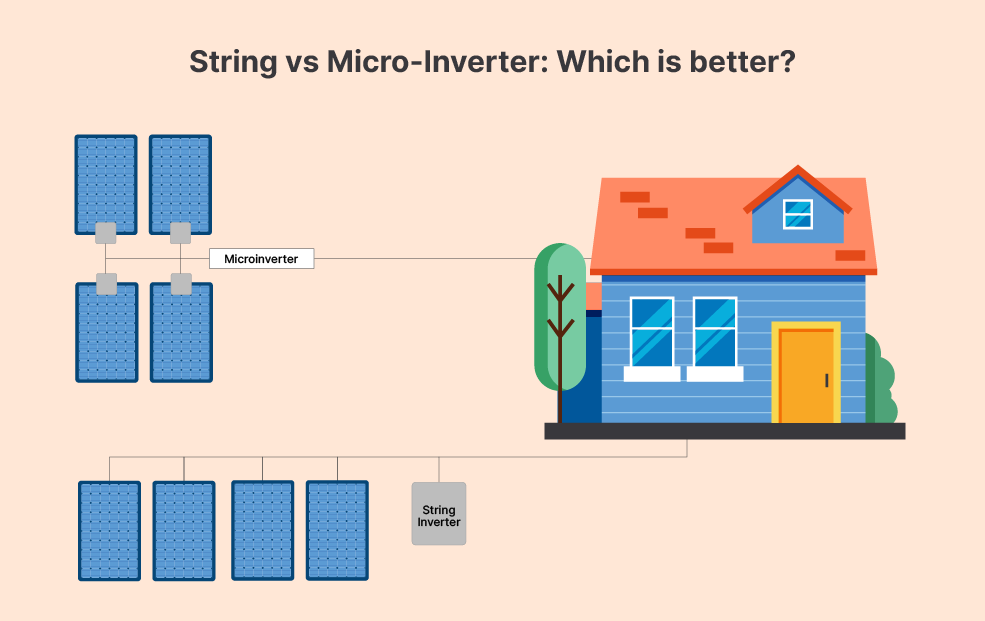
Shading
This is a critical consideration since string inverters suffer significant performance losses of up to 50% or more when even a single panel experiences shading. According to a study by the National Renewable Energy Laboratory (NREL), string inverter systems in partially shaded conditions can generate 7-26% less energy compared to microinverter systems. Shading can be a concern if trees, chimneys, or complex roof structures obstruct the solar panels. In this case, microinverters are a clear choice, as each panel maintains optimal output regardless of shading on other panels.
Module orientation
String inverters work best with uniform panel orientation, where all panels face the same direction and receive similar sunlight exposure. In situations with multiple roof panels or varying panel orientations, microinverters offer greater flexibility, maximizing energy production from each panel despite their positioning.
System size
String inverters remain cost-effective for larger, unshaded installations (typically above 10 kW). Their lower upfront cost makes them ideal for larger commercial projects where maximizing efficiency isn’t the sole priority. However, microinverters can be a worthwhile investment despite their higher initial cost for smaller residential systems (below 5 kW) where space is limited and maximizing efficiency is crucial.
Future expansion
If future system expansion is a possibility, microinverters offer greater flexibility where panels can be easily integrated with minimal system modifications. String inverters, on the other hand, might require a complete system redesign or inverter replacement to accommodate significant system growth.
Monitoring and maintenance
String inverters provide a centralized overview of system performance, but troubleshooting specific panel issues can be time-consuming. Microinverters simplify maintenance and pinpoint performance issues quickly with their individual panel monitoring. This is particularly valuable for large or complex systems. By carefully considering these factors, installers can make informed decisions. String inverters remain a solid choice for larger, unshaded systems. Microinverters excel in situations with shading, complex roof layouts, smaller system sizes, or a desire for future expansion and detailed monitoring capabilities.
Installation and maintenance strategies to keep costs down for your customers
In a highly competitive solar energy market, cost-effectiveness is critical for solar installers and their customers. As solar adoption continues to rise, the pressure to deliver efficient and affordable solutions has never been more intense. Consequently, solar installers must explore innovative installation and maintenance strategies that can help keep costs down without compromising the quality or performance of the solar system. By optimizing these processes, solar installers can provide their customers with the best value and drive further growth in the industry.
Optimizing system design
The foundation of a cost-effective system lies in its design. Expert installers play a crucial role in selecting the most appropriate technology for each project. For instance, a well-designed system layout utilizing string inverters can be a significant cost saver in situations with minimal shading concerns. String inverters generally have a lower upfront cost compared to microinverters. Carefully considering factors like roof orientation and potential shading sources during the design phase is important. This helps installers minimize the need for microinverters, leading to a more budget-friendly solution for the customer without compromising the overall system performance.
Streamlining the installation process
The installation process itself can also impact overall costs. While both string and microinverters require skilled professionals for installation, there are some key differences to consider. String inverter systems typically involve fewer components than microinverters since each panel in a microinverter system requires a dedicated unit. This can potentially translate to a slightly faster installation time for string inverter systems. However, the modular nature of microinverters can offer advantages in certain situations. For example, if future system expansion is a possibility, microinverters allow for easier integration of additional panels without requiring significant modifications to the existing system. This flexibility can save time and labor costs, even though the initial installation might be slightly faster with string inverters.
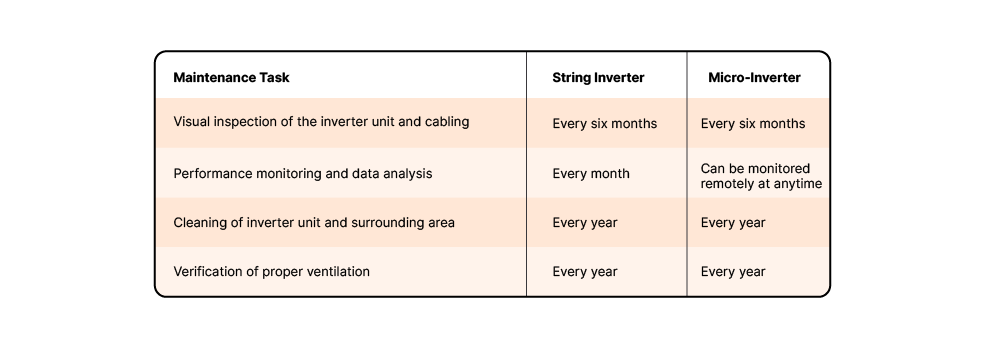
Long-term maintenance considerations
Looking beyond the initial installation, an essential strategy for cost reduction lies in minimizing ongoing maintenance needs. While both string and microinverters require preventative maintenance to ensure optimal performance, microinverters offer some potential benefits in this area. Since each panel has its dedicated microinverter, troubleshooting becomes more efficient. In the event of a performance issue, the system can identify the exact panel experiencing problems, allowing for faster and more targeted maintenance. This can save time and resources compared to string inverters, where identifying the source of a power output dip within a string can be more time-consuming.
Preventive maintenance helps both systems extend their lifespan
Regardless of the inverter type chosen, a commitment to preventative maintenance is crucial for long-term cost savings. Regular inspections by qualified technicians can identify potential problems early on, preventing them from escalating into more expensive repairs down the road. We have summarized the typical maintenance requirements for both string and microinverters below.
Pros and cons of string inverters and microinverters – striking a balance
Choosing the right inverter technology depends on carefully analyzing both advantages and limitations.
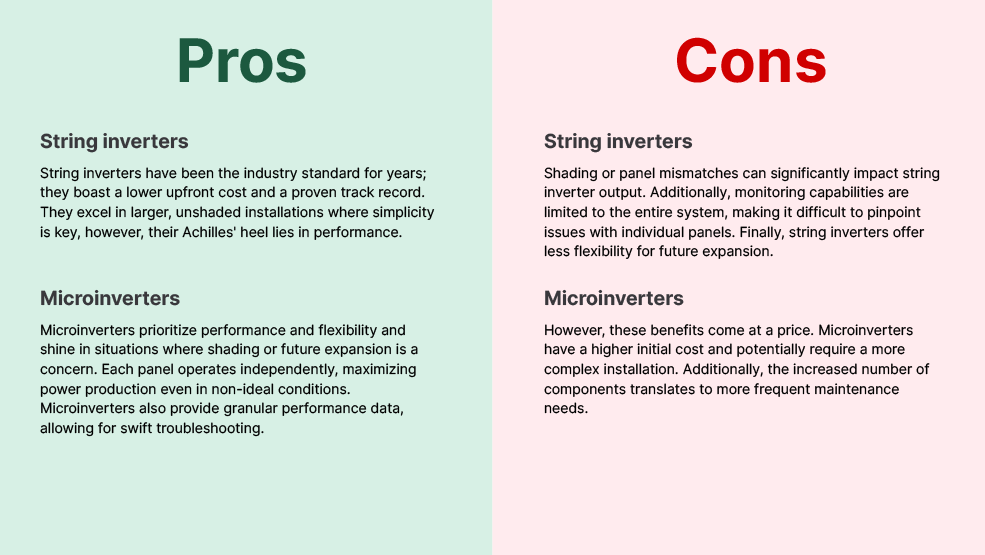
Ultimately, the best choice depends on your specific project requirements. String inverters offer a cost-effective solution for larger, simpler systems, while microinverters prioritize performance and flexibility for more complex installations.
Empower efficiency and maximize your solar investment
As solar energy continues to gain momentum, solar installers are faced with the crucial decision of selecting the right inverter technology to power their customers’ systems. Whether it’s the cost-effective reliability of string inverters or the performance-enhancing capabilities of microinverters, the choice can significantly impact the overall efficiency and return on investment for solar installation. Thus, selecting the right inverter technology is essential for a successful solar installation. We have developed some practical tips below to help you make this decision easier.
Conduct thorough site assessment
Before diving into specifics, meticulously evaluate the installation site. This includes roof size, orientation, potential shading sources (trees, chimneys), and the overall layout. This information forms the foundation for making informed choices about inverter needs.
Consider project specifics
Your budget, tentative system size, and desired performance all play a crucial role. String inverters might be ideal for larger, unshaded projects with budget constraints. However, if maximizing power output from potentially shaded areas or future system expansion is a priority, microinverters might be a better fit.
Leverage decision-making tools
Several software programs and online calculators can assist in inverter selection. These tools consider system size, shading patterns, and historical weather data to calculate potential energy production with different inverter options. This data can be instrumental in comparing the long-term cost-effectiveness of string vs. microinverter solutions.
Seek expert guidance
Don’t hesitate to consult with experienced solar professionals or inverter manufacturers. Their expertise can be invaluable in navigating complex scenarios and ensuring you choose the most suitable technology for your specific project. By collaborating with these resources, you can make confident decisions that optimize system efficiency and maximize your client’s solar investment.
A roadmap to informed decisions
We hope this comprehensive guide equipped you with the knowledge and tools to navigate the world of string inverters vs. microinverters. We’ve discussed the impact of shading, panel mismatches, and temperature variations, along with the pros and cons of each technology in terms of monitoring, maintenance, and system flexibility. Remember, selecting the right inverter depends on thoroughly understanding your client’s project specifics, budget, system size, shading concerns, and desired performance.
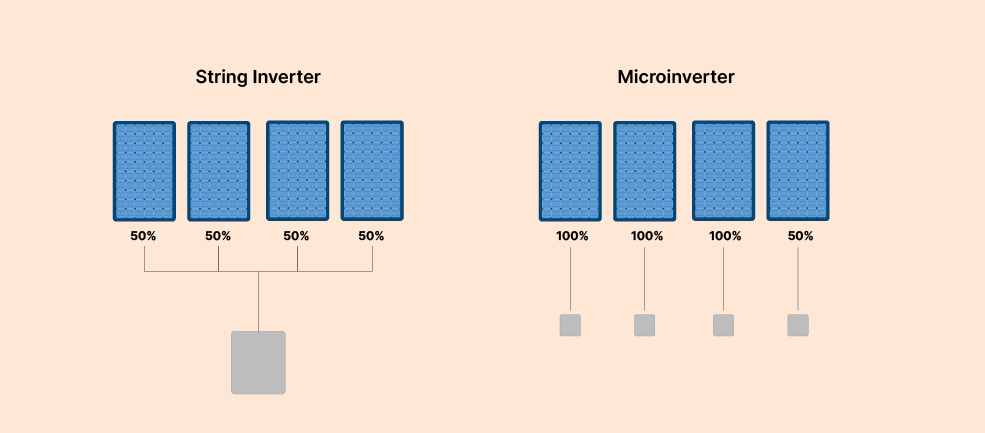
The solar industry is constantly evolving, with advancements in inverter technology occurring rapidly. By staying informed about these trends, you can continue to make optimal choices for each unique installation. Ready to take your solar expertise to the next level? Explore the wealth of resources available on Zuper’s website, where you’ll find in-depth guides, industry insights, and valuable decision-making tools. Our team is just a click away; schedule a personalized demo to discuss your project needs and explore how Zuper’s innovative solutions can empower you to deliver exceptional, cost-effective solar installations for your clients. Let’s chart a brighter future together, one efficient solar panel at a time!
